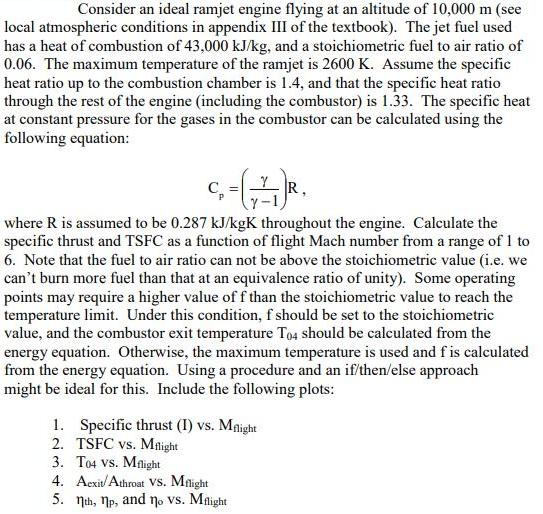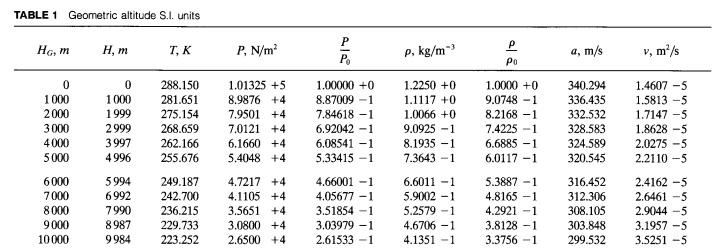Answered step by step
Verified Expert Solution
Question
1 Approved Answer
Consider an ideal ramjet engine flying at an altitude of 10,000 m (see local atmospheric conditions in appendix III of the textbook). The jet


Consider an ideal ramjet engine flying at an altitude of 10,000 m (see local atmospheric conditions in appendix III of the textbook). The jet fuel used has a heat of combustion of 43,000 kJ/kg, and a stoichiometric fuel to air ratio of 0.06. The maximum temperature of the ramjet is 2600 K. Assume the specific heat ratio up to the combustion chamber is 1.4, and that the specific heat ratio through the rest of the engine (including the combustor) is 1.33. The specific heat at constant pressure for the gases in the combustor can be calculated using the following equation: where R is assumed to be 0.287 kJ/kgK throughout the engine. Calculate the specific thrust and TSFC as a function of flight Mach number from a range of 1 to 6. Note that the fuel to air ratio can not be above the stoichiometric value (i.e. we can't burn more fuel than that at an equivalence ratio of unity). Some operating points may require a higher value of f than the stoichiometric value to reach the temperature limit. Under this condition, f should be set to the stoichiometric value, and the combustor exit temperature To4 should be calculated from the energy equation. Otherwise, the maximum temperature is used and f is calculated from the energy equation. Using a procedure and an if/then/else approach might be ideal for this. Include the following plots: 1. Specific thrust (I) vs. Maight 2. TSFC vs. Mnight 3. To4 vs. Mnight 4. Aexi/Athroat vs. Mnight 5. Nth, Np, and no vs. Mnight TABLE 1 Geometric altitude S.I. units , , T, K P, N/m? p. kg/m-3 a, m/s v, m/s P. Po 288.150 1.01325 +5 8.9876 +4 1.00000 +0 1.0000 +0 340.294 336.435 1.2250 +0 1.4607 -5 1000 1000 281.651 8.87009 -1 1.1117 +0 9.0748 -1 1.5813 -5 2000 1999 275.154 7.9501 +4 7.84618 -1 1.0066 +0 8.2168 -1 332.532 1.7147 -5 3000 2999 268.659 7.0121 +4 6.92042 -1 9.0925 -1 7.4225 -1 328.583 1.8628 -5 4000 3997 262.166 6.1660 +4 6.08541 -1 8.1935 -1 6.6885 -1 324.589 2.0275 -5 5 000 4996 255.676 5.4048 +4 5.33415 -1 7.3643 -1 6.0117 -1 320.545 2.2110 -5 6000 5994 249.187 4.7217 +4 4.66001 -1 6.6011 -1 5.3887 -1 316.452 2.4162 -5 7000 6992 242.700 4.1105 +4 4.05677 -1 5.9002 -1 4.8165 -1 312.306 2.6461 -5 8000 7990 236.215 3.5651 +4 3.51854 -1 5.2579 -1 4.2921 -1 308.105 2.9044 -5 9000 8987 229.733 3.0800 +4 3.03979 -1 4.6706 -1 3.8128 -1 303.848 3.1957 -5 10000 9984 223.252 2.6500 +4 2.61533 -1 4.1351 -1 3.3756 -1 299.532 3.5251 -5
Step by Step Solution
★★★★★
3.41 Rating (157 Votes )
There are 3 Steps involved in it
Step: 1

Get Instant Access to Expert-Tailored Solutions
See step-by-step solutions with expert insights and AI powered tools for academic success
Step: 2

Step: 3

Ace Your Homework with AI
Get the answers you need in no time with our AI-driven, step-by-step assistance
Get Started


